2019-2020学年第一学期二年级英语期末试卷
2019-2020松江区一模英语试卷
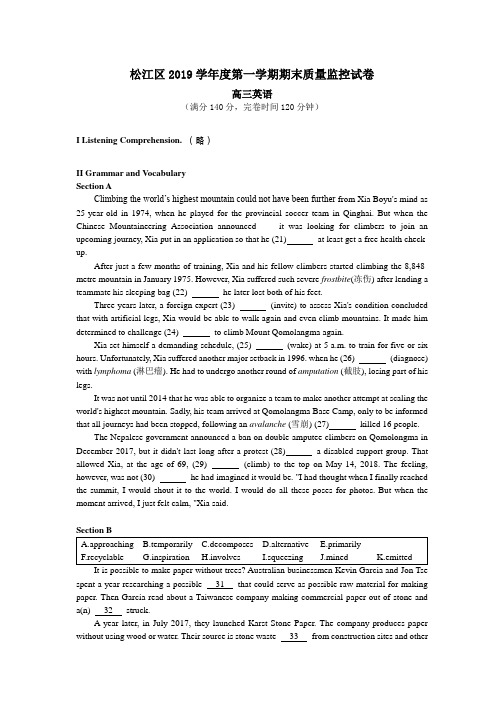
松江区2019学年度第一学期期末质量监控试卷高三英语(满分140分,完卷时间120分钟)I Listening Comprehension. (略)II Grammar and VocabularySection AClimbing the world’s highest mountain could not have been further from Xia Boyu's mind as 25-year-old in 1974, when he played for the provincial soccer team in Qinghai. But when the Chinese Mountaineering Association announced it was looking for climbers to join an upcoming journey, Xia put in an application so that he (21) at least get a free health check-up.After just a few months of training, Xia and his fellow climbers started climbing the 8,848-metre mountain in January 1975. However, Xia suffered such severe frostbite(冻伤) after lending a teammate his sleeping bag (22) he later lost both of his feet.Three years later, a foreign expert (23) (invite) to assess Xia's condition concluded that with artificial legs, Xia would be able to walk again and even climb mountains. It made him determined to challenge (24) to climb Mount Qomolangma again.Xia set himself a demanding schedule, (25) (wake) at 5 a.m. to train for five or six hours. Unfortunately, Xia suffered another major setback in 1996. when he (26) (diagnose) with lymphoma (淋巴瘤). He had to undergo another round of amputation (截肢), losing part of his legs.It was not until 2014 that he was able to organize a team to make another attempt at scaling the world's highest mountain. Sadly, his team arrived at Qomolangma Base Camp, only to be informed that all journeys had been stopped, following an avalanche (雪崩) (27) killed 16 people.The Nepalese government announced a ban on double-amputee climbers on Qomolongma in December 2017, but it didn't last long after a protest (28) a disabled support group. That allowed Xia, at the age of 69, (29) (climb) to the top on May 14, 2018. The feeling, however, was not (30) he had imagined it would be. "I had thought when I finally reached the summit, I would shout it to the world. I would do all these poses for photos. But when the moment arrived, I just felt calm, "Xia said.spent a year researching a possible 31 that could serve as possible raw material for making paper. Then Garcia read about a Taiwanese company making commercial paper out of stone and a(n) 32 struck.A year later, in July 2017, they launched Karst Stone Paper. The company produces paper without using wood or water. Their source is stone waste 33 from construction sites and otherindustrial waste dumps.“If you look at the whole process of how paper is traditionally made, it 34 chopping trees, adding chemicals, using lots of water and then 35 , drying and flattening it into sheets of paper,” said Garcia. “It contributes to high carbon emission and deforestation.”In 2019, Garcia estimates Karst’s paper production has helped save 540 large timber trees (成材木) from being deforested, 83,100 liters (21,953 gallons) of water from being used and 25,500 kilograms (56,218 pounds) of carbon dioxide from being 36 .“We collect disposed limestone (石灰石) from wherever we can find it, wash it, and grind it into fine powder,” he said. The powder is mixed with a HDPE resin (高密度聚乙烯树脂), which __37 over time from sunlight, leaving only calcium carbonate (碳酸钙) behind.The paper can be as thin as notebook paper or as thick as a cardboard paper and is waterproof, __38 and difficult to tear. The notebooks cost $10 to $25. Karst’s products are mainly sold through the company’s website, but are also stocked in 100 stores, 39 throughout Australia, the United States and the United Kingdo m. “O ver 70% of the customers are US-based,” he said.They hope to have the notebooks in 1,000 stores by the end of the year. Garcia said they are now thinking about 40 investors for the first time in order to scale up their operations. They declined to reveal how much the company makes or their annual revenue.III. Reading Comprehension.Section AWhat happens when the right to know comes up against the right not to know? The ease of genetic testing has brought this question to light. Two ___41___ legal cases – one in Britain, the other in Germany – stand to alter the way medicine is practiced.Both cases involve Huntington’s disease (HD), whose ___42___ inclu de loss of co-ordination (协调), mood changes and cognitive (认知的) decline. It develops between the ages of 30 and 50, and is eventually fatal. Every child of an ___43___ parent has a 50% chance of inheriting it.In the British case, ___44___ for trial at the High Court in London in November, a woman known as ABC – to protect the ___45___ of her daughter, who is a minor – is charging a London hospital, St. George’s Healthcare NHS Trust, for not ___46___ her father’s diagnosis of HD with her. ABC was pregnant at the time of his diagnosis, in 2009. She argues that had she been aware of it, she would have stopped the pregnancy. As it was, she found out only after giving birth to her daughter. She later tested ___47___ for HD.The German case is in some ways the mirror image of the British one. Unlike in Britain, in Germany the right not to know genetic information is protected in law. ___48___, in 2011 a doctor informed a woman that her divorced husband –the doctor’s patient – had tested positive for HD. This meant their two children were ___49___ the disease. She accused the doctor, who had acted with his patient’s permission. Both children being minors at the time, they could not legally be tested for the disease, which, as the women’s lawyers pointed out, is cur rently ___50___. They argued that she was therefore helpless to act on the information, and ___51___ suffered a reactive depression that prevented her from working.Both cases test a legal grey area. If the right to know is ___52___ recognized in Britain later this year, that may remove some uncertainties, but it will also create new ones. To what lengths should doctors go to track down and inform family members, ___53___?It is the law’s job to ___54___ these rights for the modern age. When the law falls b ehindtechnology, somebody often pays the price, and currently that somebody is ___55___. As these two cases demonstrate, they find themselves in a difficult situation – charged if they do, accused if they don’t.Section B(A)For Western designers, China and its rich culture have long been an inspiration for Western creative."It's no secret that China has always been a source of inspiration for designers," says Amanda Hill, chief creative officer at A+E Networks, a global media company and home to some of the biggest fashion shows.Earlier this year, the China Through A Looking Glass exhibition in New York exhibited 140 pieces of China-inspired fashionable clothing alongside Chinese works of art, with the aim of exploring the influence of Chinese aesthetics(美学) on Western fashion and how China has fueled the fashionable imagination for centuries. The exhibition had record attendance, showing that there is huge interest in Chinese influences."China is impossible to overlook," says Hill. "Chinese models are the faces of beauty and fashion campaigns that sell dreams to women all over the world, which means Chinese women are not just consumers of fashion — they are central to its movement" Of course, not only are today's top Western designers being influenced by China, but some of the best designers of contemporary fashion are themselves Chinese. "Vera Wang, Alexander Wang, Jason Wu are taking on Galliano, Albaz, Marc Jacobs — and beating them hands down in design and sales.," adds Hill.For Hill, it is impossible not to talk about China as the leading player when discussing fashion. "The most famous designers are Chinese, so are the models, and so are the consumers," she says, "China is no longer just another market; in many senses it has become the market. if you talk about fashion today, you are talking about China — its influences, its directions, its breathtaking clothes, and how young designers and models are finally acknowledging that in many ways."56. What can we learn about the exhibition in New York?A.It promoted the sales of artworks.B.It attracted a large number of visitors.C.It showed ancient Chinese clothes.D.It aimed to introduce Chinese models.57. What does Hill say about Chinese women?A. They do business all over the world.B. They admire super models.C. They start many fashion campaigns.D. They are setting the fashion58. The underlined phrase "taking on" in Paragraph 4 is closest in meaning toA. competing againstB. learning fromC. working withD. looking down on59. Which of the following is the most suitable title for the text?A. Chinese Art Exhibition Held in New YorkB. Young. Models Selling Dreams to the WorldC. Chinese Culture Fueling International Fashion TrendsD. Differences Between Eastern and Western Aesthetics(B)60. What happened to Anita Lawrence after her husband's diagnosis?A. She felt very painful.B. She gained some life lessons.C. She paid more attention to her own health.D. She showed deep sympathy for her husband61. According to Sam Kieffer's letter, what can we learn about John All?A. He is an expert in mountaineering.B. He wrote the article entitled Trapped Inside a Glacier.C. Few people could survive in the same situation as lie did.D. His story is the best one that Sam Kieffer has ever read in Reader S Digest.62. In her letter, Janet Toole quoted two examples of Switzerland and Italy in order to .A. advise chefs to stop cooking live lobstersB. show how cruel it is to cook lobsters liveC. raise chefs' awareness of protecting animalsD. share with readers these countries' laws regarding cooking(C)The newspaper must provide for the reader the facts, pure, unprejudiced, objectively selected facts. But in these days of complex news it must provide more: it must supply interpretation, the meaning of the facts. This is a very important assignment facing American journalists - to make clear to the reader the problems of the day, to make international news understandable as community news, to recognize that there is no longer any such thing as "local" news, because any event in the international area has a local reaction in the financial market, political circles, in terms, indeed, of our very way of life. There is in journalism a widespread view that when you start an interpretation, you are entering dangerous waters, the rushing tides of opinion. This is nonsense.The opponents of interpretation insist that the writer and the editor shall limit themselves to the "facts". This insistence raises two questions: What are the facts? Are the bare facts enough?As for the first question, consider how a so-called "factual" story comes about. The reporter collects, say, fifty facts; out of these fifty, his space being necessarily restricted, he selects the ten which he considers most important. This is Judgment Number One. Then he or his editor decides which of these ten facts shall make up the beginning of the article, which is an important decision because many readers do not proceed beyond the first paragraph. This is Judgment Number Two. Then the night editor determines whether the article shall be presented on page one, where it has a large influence, or on page twenty-four, where it has little. Judgment Number Three.Thus in the presentation of a so-called "factual" or "objective" story, at least three judgments are involved. And they are judgments not at all unlike those involved in interpretation, in which reporters and editors, calling upon their research resources, their general background, and their -news neutralism", arrive at a conclusion as to the significance of the news.The two areas of judgment, presentation of the news and its interpretation, are both objective and subjective processes. If an editor is determined to give a prejudiced view of the news, he can do it in other ways and more effectively than by interpretation. He can do it by the selection of those facts that support his particular viewpoint. Or he can do it by the place he gives a story - promoting it to page one or dragging it to page thirty.63. According to the first paragraph. Which of the following statements is TRUE?A. If a reporter makes clear the facts he writes, he will no doubt get into trouble.B. Journalists must select facts objectively to make current events clear to the readers.C. The most important task of reporters is to provide unprejudiced facts for the readers.D. For reporters, interpretation of facts is no less important than presentation of the facts.64. The beginning of the article should present the most important fact because .A. it will influence the reader to continueB. most readers read only the first paragraphC. it details the general attitude of the writerD. it's the best way to write according to the schools of journalism65. Where a story is presented in a newspaper shows .A. the editor's prejudiceB. the reporter's backgroundC. the story's factual matterD. the story's effect on the readers66. Which of the following can best express the author's altitude toward objectiveness?A. Objectiveness is controlled by editors rather than writers.B. Properly choosing facts prepares a solid ground for objectiveness,C. He doesn't think there exists complete objectiveness in news writing.D. To make clear the news is a way to be objective and responsible for the readers.When he rolls into a gas station to fill his tank, Barkhad Dahir doesn't get out of his car. He pushes a few buttons on his cellphone and within seconds he has paid for the fuel. With the same quick pushes on his phone he pays for almost everything he needs.Electronic payments offer consumers convenience, provide profits for banks, credit card companies and payment processors and offer merchants improved cash flow and convenience. "I haven't seen cash for a long time. Almost every merchant even hawker (小贩) on the street accepts payment by cellphone. 67. " Says Adan Abokora, a democracy activist.Purchases are made by dialing a three-digit number, entering a four-digit PIN and then entering the retailer's payment number and the amount of money. Both customers and merchants receive text messages to confirm the payment. 68. For instance, the printing and handling of money is expensive. Cash payments can be anonymous (匿名的) and it is hard to track criminal activities conducted in secret. Many governments favor reducing cash dealings in order to better monitor and understand the activities of their citizens. The Swedish government has been discussing the removing of cash since 2010.69. Do they choose to rob? Do they sit at home and wait? What happens to people who rely on their cellphones to process money dealings when cell service and the Internet are interrupted?A world affected by terrorism and increasingly violent weather may not yet be ready to abandon currency."Other people fear that electronic payments may create security risks and enable dealings to be tracked and reported. 70. New technologies which balance and address these factors may enable people to remove cash.IV. Summary WritingIt goes without saying that the language spoken by the majority of British people has the same name as the language spoken by most citizens of the U.S.A. Nonetheless, quite apart from well-documented lexical (词汇的) differences pavement/sidewalk, lift/elevator, etc. —there are still some words and phrases which can cause confusion and misunderstanding between speakers of the two different forms. That's why some people say that Great Britain and the United States are nations separated by a common language. There are practical reasons for this.When the first English settlers arrived in what we now call America, the language they spokewas naturally the same as that spoken by their compatriots (同胞) on the other side of the Atlantic Ocean. However, they immediately saw things which didn't exist in Europe, often items used and made by Native Americans, such as canoes and moccasins and creatures such as buffalo. They also picked up words which they heard being used by other European immigrants. The word "boss", for example, was used by settlers from Holland in New York in the mid-17th century. It comes from the Dutch word "baas", which means master. The word "cookie" also comes from the Dutch "koekje".There are many words, phrases and even grammatical structures which are mistaken for Americanisms (美式英语用语) in Britain when they are nothing of the sort. Very often, they represent not an American import, but an original form of British English which has disappeared in Britain_ The verbs "guess" meaning think and "loan" meaning lend and the adjective "mad" meaning angry are frequently criticized as Americanisms, yet they all appeared in British English hundreds of years ago. In the case of "loan", it was used as long ago as 1,200 years! In fact, English spoken in the UK has changed so thoroughly in the last 500 years that American English now represents the last place where some original British English forms can he found.V. Translation72. 他很少意识到与他人交流的重要性。
北京市丰台区 2019~2020 学年度第一学期二年级英语第一单元试卷
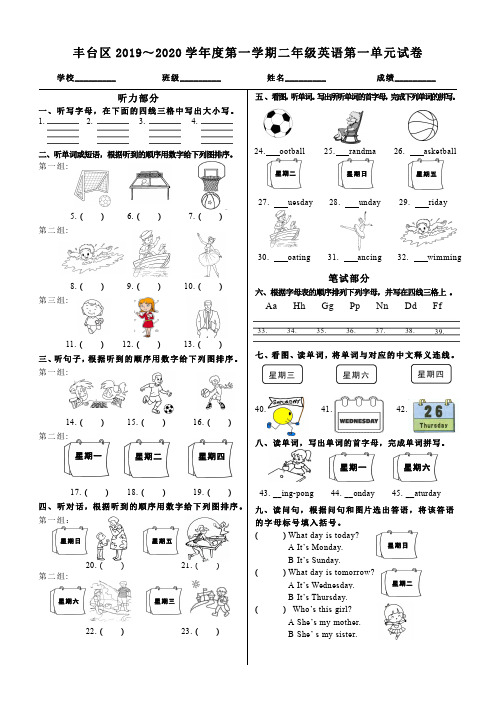
( ) 45. Let’s go and see them.
十、 读句子,找 出 与 句 子 意 思 相 符 的 图片, 将 答 案 的字母标号填入括号。
( ) 46. My number is twelve. D.
( ) 47. There are so many toys.
( ) 48. It’s Thursday today.
星期三
星期六
星期四
14. ( ) 第二组:
星期一
15. ( ) 星期二
16. ( ) 星期四
40.
41.
42.
八、读单词,写出单词的首字母,完成单词拼写。
星期一
星期六
17. ( ) 18. ( )
19. ( )
43. __ing-pong 44. __onday 45. __aturday
四、 听对话,根据听到的顺序用数字给下列图排序 。 九、读问句,根据问句和 图片选出答语,将该答语
A.
B.
C.
D.
17. ( )
18. ( )
19. ( )
五 、 听对话,根据对话内容的顺序用数字给下列图排序。
第一组:
星期三
星期五
20. ( )
第二组:
星期二
22. ( )
21. ( )
星期日
23. ( )
十、读问句,根据问句和图片选出答语,将该答语 的字母标号填入括号。 ( ) 46. What do you do on Saturday?
14. ( ) 第二组:
15. ( )
16. ( )
九、读句子,找出与句子内容相符的图片, 将答案 的字母标号填入括号。 ( ) 42. I often play chess on Saturday. ( ) 43. We often play football in the afternoon. ( ) 44. I draw pictures on Sunday. ( )45. I often watch cartoons in the evening.
新部编人教版小学二年级英语上册期末检测试卷
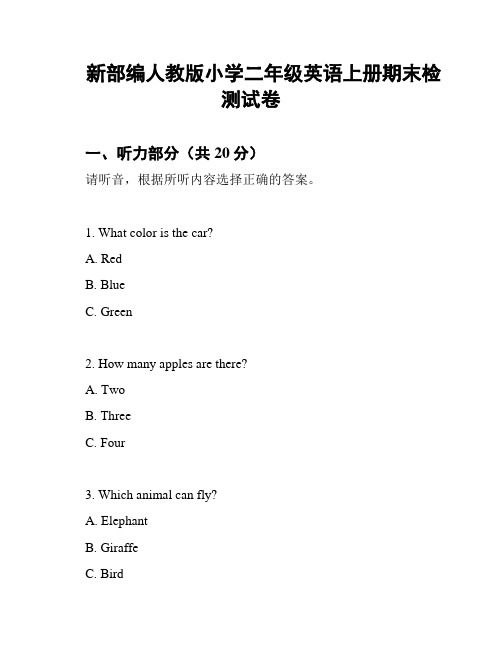
新部编人教版小学二年级英语上册期末检测试卷一、听力部分(共20分)请听音,根据所听内容选择正确的答案。
1. What color is the car?A. RedB. BlueC. Green2. How many apples are there?A. TwoB. ThreeC. Four3. Which animal can fly?A. ElephantB. GiraffeC. Bird4. What is the girl doing?A. ReadingB. DancingC. Singing5. Where is the apple?A. On the tableB. Under the chairC. Behind the door二、选择正确的单词填空(共15分)根据图片选择正确的单词填空。
1. The dog is ________.A. runningB. cryingC. sleeping2. The cat is ________.A. eatingB. jumpingC. swimming3. The boy is ________.A. playingB. sleepingC. studying4. The girl is ________.A. singingB. cleaningC. cooking5. The bird is ________.A. flyingB. crawlingC. swimming三、根据所给的答句选择正确的问句(共15分)1. ________ It's red.A. What color is the car?B. What is the cat doing?C. How many apples are there?2. ________ She is reading a book.A. What is the girl doing?B. What color is the dog?C. How many birds are there?3. ________ I am playing football.A. What is the boy doing?B. What is the bird doing?C. How many bananas are there?4. ________ It's behind the door.A. Where is the ball?B. Where is the apple?C. Where is the chair?5. ________ Five.A. How many apples are there?B. How many cats are there?C. How many dogs are there?四、阅读理解(共15分)阅读短文,选择正确的答案。
部编版2019-2020学年三年级下学期英语期末考试试卷(含完整音频无材料)A卷

部编版2019-2020学年三年级下学期英语期末考试试卷(含完整音频无材料)A卷姓名:________ 班级:________ 成绩:________小朋友,带上你一段时间的学习成果,一起来做个自我检测吧,相信你一定是最棒的!一、 Listen and number.听录音,给下列单词标号。
(共4题;共12分)1. (3分)选出你所听到的单词()A . armB . cardC . party2. (3分)听朗读,把听到的内容的代号填在括号内()A . mouseB . mouthC . house3. (3分)听录音,选出你所听到的单词()A . clubB . cookC . comic4. (3分)听录音,选择你所听到的单词()A . bearB . catC . dog二、 Listen and tick(听录音,选出与所听内容相符的 (共4题;共8分)5. (2分)听音,选出与你听到的内容意思相符的图片()A .B .C .6. (2分)听录音,选择相应的图片()A .B .C .7. (2分)听录音,选择相应的答语()A . Sure, it's over there.B . OK, here you are.C . Yes, I want to buy a coat.8. (2分)听句子,给图片排序________________________________________三、 Listen and circle.(听录音,圈出你听到的内 (共6题;共12分)9. (2分)听句子,选出句子中含有的信息()A . takeB . tookC . lake10. (2分)听录音,选出你所听到的句子()A . We have two friends.B . We have a new friend.11. (2分)My uncle looks very serious.12. (2分)13. (2分)听录音,选出你所听到的句子()A . My name is Jenny.B . I'm Jenny.14. (2分)听录音,给所听问句选择恰当的答语()A . My name is Zhang Peng.B . He's Zhang Peng.C . Hi, Zhang Peng.四、 Listen and match.(听录音,将相关内容匹配。
【期末试卷】2019-2020学年第一学期九年级英语学科期末质量监测试卷及答案

【期末试卷】2019-2020学年第⼀学期九年级英语学科期末质量监测试卷及答案2019-2020学年第⼀学期九年级英语学科期末质量监测试卷(满分:150分考试时间:120分钟)注意:请把所有答案填涂或书写到答题卡上!请不要错位、越界答题!在本试卷上答题⽆效。
祝你取得好成绩!⼀、听⼒部分(30分)I. 听⼒(共三节, 20⼩题, 每⼩顾1.5分, 满分30分)第⼀节听句⼦听下⾯五个句⼦, 从每⼩题所给的三幅图中选出与句⼦内容相符的选项。
每个句⼦读两遍。
第⼆节听对话听下⾯七段对话, 从每⼩题所给的A,B,C三个选项中选出正确选项。
每段对话读两遍。
听第1段对话, 回答第6⼩题。
6. When did Sally get to the airport this morning?A. At 7:50B. At 8:00C. At 8:10.听第2段对话, 回答第7⼩题。
7. What are they talking about?A. The pollution.B. The population.C. The pronunciation听第3段对话, 回答第8⼩题。
8. How does the woman feel about listening to the radio?A. Relaxing.B. Boring.C. Easy.听第4段对话, 回答第9⼩题。
9. What does Jenny do to help protect the environment?A. She reuses plastic bags.B. She reuses paper cups.C. She reuses plastic bottles.听第5段对话, 回答第10, 11⼩题。
10. What does the girl think is the greatest invention?A. The smartphone.B. The computer.C. The TV11. What does the boy's sister use the computer for?A. Playing computer games.B. Studying English.C. Watching TV plays.听第6段对话, 回答第12, 13⼩题。
北京市西城区2019-2020学年度初二上学期英语期末试卷(WORD版含听力材料和答案)

北京市西城区2019-2020学年度第一学期期末试卷八年级英语听力理解(共20分)一、听下面四段对话或独白。
每段对话或独白后有两道小题, 从每题所给的A,B,C三个选项中选出最佳选项。
每段对话或独白你将听两遍。
(共12分, 每小题1.5分)听下面一段对话, 完成第1至第2小题1. What does the man buy?A. A scarf.B. A hat.C. A T-shirt.2. How much is it?A. 60 dollars.B. 19 dollars.C. 30 dollars.听下面一段对话, 完成第3至第4小题3. What are the speakers going to do finally?A. Go to the cinema.B. Go shopping.C. Go ice skating.4. Where are they going to meet?A. At the shopping center.B. Near the cinema.C. At the school gate.听下面一段对话, 完成第5至第6小题5. What is Sally good at?A. Football.B. Japanese.C. Computers.6. What does Sally want to do?A. Get a job.B. Play sports.C. Study Art.听下面一段独白, 完成第7至第8小题7. Who invented Pompodoro Technique?A. Peter.B. Peter's Dad.C. An Italian man.8. What is the speech mainly about?A. The history of Pompodoro Technique.B. The introduction of Pompodoro Technique.C. The importance of Pompodoro Technique.二、听独白, 记录关健信息。
2019-2020学年人教版九年级英语第一学期期末测试卷(含答案)
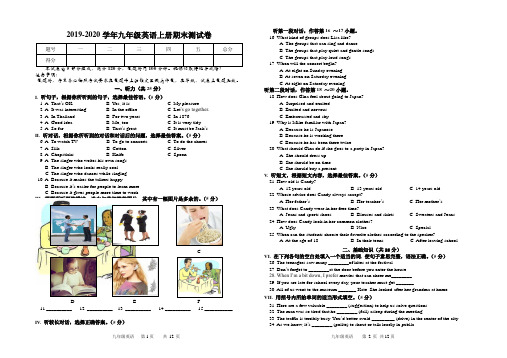
2019-2020学年九年级英语上册期末测试卷题号一二三四五总分得分本试卷由5部分组成,满分120分,答题时间100分钟。
祝你们取得优异成绩!注意事项:答题时,考生务必按照考试要求在答题卡上的指定区域内作答,在草纸、试卷上答题无效。
一、听力(共25分)I. 听句子,根据你所听到的句子,选择最佳答语。
(5分)1. A. That’s OK. B. Yes, it is. C. My pleasure.2. A. It was interesting. B. In the office. C. Let’s go together.3. A. In Thailand. B. For two years. C. In 1876.4. A. Good idea. B. Me, too. C. It is very tidy.5. A. So far. B. That’s great. C. It must be Jack’s.II. 听对话,根据你所听到的对话和对话后的问题,选择最佳答案。
(5分)6. A. To watch TV. B. To go to concerts. C. To do the chores.7. A. Silk. B. Cotton. C. Silver.8. A. Chopsticks. B. Knife. C. Spoon.9. A. The singer who writes his own songs.B. The singer who looks really cool.C. The singer who dances while singing.10. A. Because it makes the talkers happy.B. Because it’s easier for people to learn more.C. Because it gives people more time to work.III. 根据所听到的描述,选出与其相符的图片。
2020年二年级英语2b期末试卷
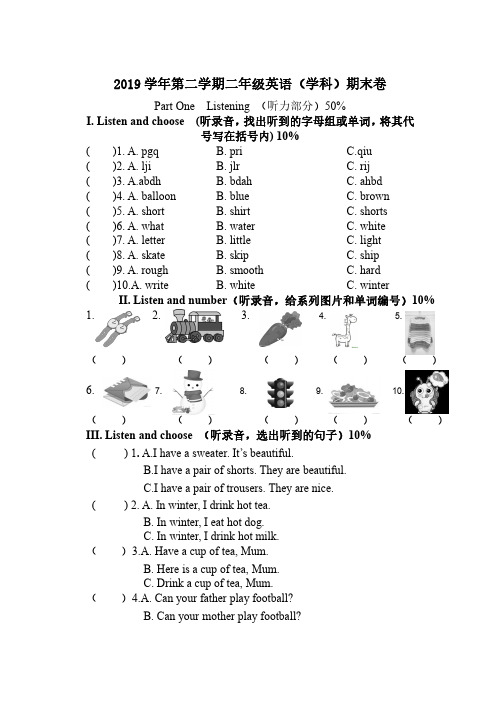
2019学年第二学期二年级英语(学科)期末卷Part One Listening(听力部分)50%I.Listen and choose(听录音,找出听到的字母组或单词,将其代号写在括号内)10%()1.A.pgq B.pri C.qiu()2.A.lji B.jlr C.rij()3.A.abdh B.bdah C.ahbd()4.A.balloon B.blue C.brown()5.A.short B.shirt C.shorts()6.A.what B.water C.white()7.A.letter B.little C.light()8.A.skate B.skip C.ship()9.A.rough B.smooth C.hard()10.A.write B.white C.winterII.Listen and number(听录音,给系列图片和单词编号)10% 1. 2. 3.4. 5.()()()()()6.7.8.9.10.()()()()()III.Listen and choose(听录音,选出听到的句子)10%()1.A.I have a sweater.It’s beautiful.B.I have a pair of shorts.They are beautiful.C.I have a pair of trousers.They are nice.()2.A.In winter,I drink hot tea.B.In winter,I eat hot dog.C.In winter,I drink hot milk.()3.A.Have a cup of tea,Mum.B.Here is a cup of tea,Mum.C.Drink a cup of tea,Mum.()4.A.Can your father play football?B.Can your mother play football?C.Can your father play basketball?()5.A.In spring,we like riding our bicycles outside.B.In spring,we like playing our kites outside.C.In autumn,we like playing our kites outside.IV.Listen and judge(听录音,判断句子与听到的内容是否一致,一致的用“T”表示,不一致的用“F”表示)10%()1.What can you see?I can see two butterflies.()2.Down by the station.Waiting for the van.()3.Monkey,monkey,what do you like eating?I like eating bananas.()4.Winter is windy and cold.I like skating on the ice.()5.What can I do for you,Mum?V.Listen and choose(听录音,选出相应的应答句,将其代号写在括号内)10%()1.A.It’s pink.()2.A.Yes,it is soft.()3.A.OK()4.A.I can swim.()5.A.Yes,I can hear a car.()6.A.Here you are.()7.A.Yes,I can()8.A.I can see black in the rainbow. ()9.A.Happy Mother’s Day.()10.A.Ok,let’s go.B.They’re pink.B.No,it is soft.B.Thank you.B.I like swimming.B.I can hear a car.B.Yes,please.B.Yes,I do.B.I can see yellow in the rainbow.B.Thank you.B.That’s all right.Part2Reading and writing(第二部分读写部分)50% I.正确抄写句子5%Listen!What can you hear,Alice?I can hear a dog.Џ.Write the words(看图写单词或词组)6%————————————————————————————————————III.Read and judge(朗读句子,判断句子内容是否与图片一致,一致用√,不一致用×表示)7%()1.Alice can make a paper bird.()2.They can make a snowman in autumn.()3.Can the girl swim?Yes,she can.()4.How many balloons are there?Four.()5.Boop,boop,I can hear a bus.()6.Touch the pineapple.It isn’t smooth.()7.Kitty has a blouse,It’s very nice.Ⅳ.Read and choose(选出不同类的词,将字母代号写在前面括号)8%1.()A.giraffe B.snake C.hen D.meat2.()A.cloudy B.rainy C.sun D.cold3.()A.rope B.hop C.ride D.skate4.()A.hand B.gloves C.head D.nose5.()A.in B.on C.cross D.under6.()k B.rice C.cake D.noodles7.()A.fat B.thin C.tall D.shorts8.()A.go B.wait C.fast D.stopⅤ.Choice(选择)7%()1.----May I have______rice?----Here you are.A.someB.aC.a bowl()2.---Smell the cake.Is it_____?---Yes it is.A.nice B.yellow C.soft()3.---What colour are the pigs?---__________A.It’s pink.B.They’re pink.C.They’re fat.()4.There____some sheep and a zebra in the park.A.isB.areC.have()5.---Do the cats like fish?---_____________A.Yes,they do.B.Yes,they can.C.No,they don’t.()6.The chair isn’t soft.It’s________A.hardB.smoothC.soft()7.I see three_____on the flower.A.butterflysB.butterflyC.butterfliesⅥ.Read and match(问答配对)5%()1.What colour are the pears? A.A bicycle.()2.What do you like eating? B.Yes,I do.()3.Can he play basketball? C.No,he can’t.()4.Do you like skipping? D.I like eating fish.()5.What can you hear? E.They are yellow.Ⅶ.Read and judge(阅读短文,判断句子内容是否与短文一致,一致用√,不一致用×表示)12%Today is Jane’s birthday.Her friends are at her home.There is some fruit and a birthday cake on the small table.And you can see some food on the big table. Kitty likes pizzas,Ben likes salad.Danny likes chichen and noodles.Jane’s father and mother like noodles,too.They sing and dance together.They can eat the food. They are happy.()1.Today is Kitty’s birthday.()2.There is some fruit and a birthday cake on the big table.()3.Danny likes chicken and noodles.()4.Jane’s father like noodles,too.()5.They can only dance..()6.They are happy.w W w.2012学年第二学期二年级英语(学科)期末卷答案Part One Listening(听力部分)50%I.Listen and choose(听录音,找出听到的字母组或单词,将其代号写在括号内)10%1.B.pri2.A.lji3.B.bdah4.B.blue5.A.short6.B.water7.C.light8.C.ship9.A.rough10.C.winterII.Listen and number(听录音,给系列图片和单词编号)10% 1.giraffe2.snowman3.carrot4.light5.watch6.letter7.sweater8.salad9.train10.hungry5,9,3,1,7,6,2,4,8,10III.Listen and choose(听录音,选出听到的句子)10%1.C.I have a pair of trousers.They are nice.2.C.In winter,I drink hot milk.3.A.Have a cup of tea,Mum.4.A.Can your father play football?5.B.In spring,we like playing our kites outside.IV.Listen and judge(听录音,判断句子与听到的内容是否一致,一致的用“T”表示,不一致的用“F”表示)10%1.What can you see?I can see two butterflies.T2.Down by the station.Waiting for the train.F3.Monkey,monkey,what do you like eating?I like eating bananas.T4.Winter is cloudy and cold.I like skating on the ice.F5.What can I do for Mum?FV.Listen and choose(听录音,选出相应的应答句,将其代号写在括号内)10%1.What colour is the coat?A2.Is it rough?B3.Here is a card for you.B4.What do you like doing?B5.What can you hear?B6.Give me a carnation,please.A7.Do you like eating carrots?B8.What colour can you see in the rainbow?B9.Happy Mother’s Day.B10.Look at the light.It’s green.APart2Reading and writing(第二部分读写部分)50%I.正确抄写句子5%Listen!What can you hear,Alice?I can hear a dog.Џ.Write the words(看图写单词或词组)6%Chicken letter hot sweater salad shortsIII.Read and judge(朗读句子,判断句子内容是否与图片一致,一致用T,不一致用F表示)7%1.T2.F3.F4.T5.F6.F7.FⅣ.Read and choose(选出不同类的词,将字母代号写在前面括号)8%1.D2.C3.A4.B5.C6.A7.D8.CⅤ.Choice(选择)7%1.B2.A3.B4.B5.A6.A7.CⅥ.Read and match(问答配对)5%1.E2.D3.C4.B5.AⅦ.Read and judge(阅读短文,判断句子内容是否与短文一致,一致用T,不一致用F表示)12%1.F2.T3.T4.F5.F6.T。
- 1、下载文档前请自行甄别文档内容的完整性,平台不提供额外的编辑、内容补充、找答案等附加服务。
- 2、"仅部分预览"的文档,不可在线预览部分如存在完整性等问题,可反馈申请退款(可完整预览的文档不适用该条件!)。
- 3、如文档侵犯您的权益,请联系客服反馈,我们会尽快为您处理(人工客服工作时间:9:00-18:30)。
学校
班级
姓名
考号
―――――――――――――-―密――――――――――封―――――――――线――――――――――――――――――――
2019-2020 学年第一学期二年级英语期末考查卷
(考试时间:40 分钟)
听力部分:88 分
得分:_______________
I. Listen and circle the letters you hear. (听音,圈出你所听到的字母。
)10 分
1. Bb Dd
2. Ii Ll
3. Jj Zz
4.Tt Yy
5. Hh Ff
6. Xx Ss
7.Mm Nn
8. Vv Uu
9. Aa Rr
10. KT KD
II. Listen and choose the right pictures.(听音,选择正确的图片,将其序号填在括号内。
)18 分
1. ( ) A.
B.
2. ( ) A.
B.
3. ( ) A.
B.
4. ( ) A.
B.
5. ( ) A.
B.
6. ( ) A.
B.
7. ( ) A.
B.
8. ( ) A.
B
9. ( ) A.
B.
III.Listen and write.(下面是 panpan 的一天。
听音,将活动时间的序号填入横线中)12 分 A. 8:00 B. 12:00 C. 3:00 D. 6:00 E. 7:00 F.5:00
1._______ 2._______ 3.________ 4.________ 5.________ 6.________
IV. Listen and tick. 听音,选出每个小朋友喜欢的食物, 在相应的格子内打勾“√”。
10 分
V.Listen and number.(听音,给下列人物出行方式标号。
)12 分。
1.
2.
3.
( 4.
)
(
5.
) 6.
()
()
()
()
VI. Listen, tick or cross.(听一听小朋友们喜欢哪些食物,不喜欢哪些食物,喜欢的请打“√”,
不喜欢的请打“×”。
)8 分
1.
(
)
(
)
2.
(
)
(
)
3.
(
)
(
)
4.
(
)
(
)
1
VII. Listen and tick.(Lingling 的作业是一份周末活动调查表,请你根据听力内容来完成调查表, 在对应的空格里打√ 。
) 8 分
Activity
Place
Name
读写部分:10 分 I. Write the letters.(按照 26 个英语字母表的顺序写出所缺字母,注意大小写。
)7 分
VIII. Listen and circle. (听一听有关圣诞节的介绍,圈出正确的图片。
) 10 分
In England they have Christmas .Christmas is in(
).
They have (
) and (
).
They have a big ( They (
). ).
II. Read and choose.(读一读,将正确的答案写在横线上。
)3 分
1. We have breakfast at ________.
A. 12
B. 7
2.In winter, I wear a ________.
A .T-shirt
B. coat
3.-- Do you like apples?
-- ___________. I like apples.
A. Yes, I do.
B. No, I don’t.
附加题: Read and write.(将单词或词组与相应的图片配对,将序号 A, B, C …写在图片 下的括号中。
)10 分
A.dress
B.go to work
C.go skating
D.tomato
E.ice cream
(
)
()
( )(
)
(
)
同学们测试完毕,请你认真检查,加油,加油,加油!
2
。
